This document provides an overview of different data types in programming languages. It discusses primitive data types like integers, floating point numbers, Booleans, characters and strings. It also covers user-defined types like enumerated types, subrange types, arrays, associative arrays and records. For each type, it describes common design considerations, examples from different languages, and how they are typically implemented.









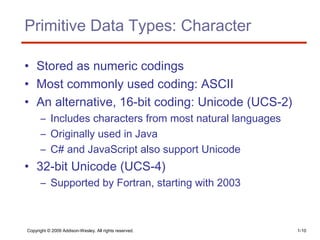





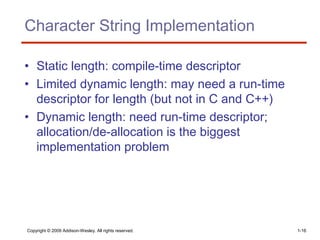














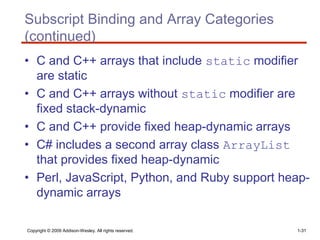
![Copyright © 2009 Addison-Wesley. All rights reserved. 1-32
Array Initialization
• Some language allow initialization at the time of
storage allocation
– C, C++, Java, C# example
int list [] = {4, 5, 7, 83}
– Character strings in C and C++
char name [] = “freddie”;
– Arrays of strings in C and C++
char *names [] = {“Bob”, “Jake”, “Joe”];
– Java initialization of String objects
String[] names = {“Bob”, “Jake”, “Joe”};](https://image.slidesharecdn.com/6datatypes-170401095536/85/6-data-types-32-320.jpg)

![Array Initialization
• C-based languages
– int list [] = {1, 3, 5, 7}
– char *names [] = {“Mike”, “Fred”,“Mary Lou”};
• Ada
– List : array (1..5) of Integer :=
(1 => 17, 3 => 34, others => 0);
• Python
– List comprehensions
list = [x ** 2 for x in range(12) if x % 3 == 0]
puts [0, 9, 36, 81] in list
Copyright © 2009 Addison-Wesley. All rights reserved. 1-34](https://image.slidesharecdn.com/6datatypes-170401095536/85/6-data-types-34-320.jpg)





![Copyright © 2009 Addison-Wesley. All rights reserved. 1-40
Implementation of Arrays
• Access function maps subscript expressions to
an address in the array
• Access function for single-dimensioned arrays:
address(list[k]) = address (list[lower_bound])
+ ((k-lower_bound) * element_size)](https://image.slidesharecdn.com/6datatypes-170401095536/85/6-data-types-40-320.jpg)

![Copyright © 2009 Addison-Wesley. All rights reserved. 1-42
Locating an Element in a Multi-dimensioned
Array
•General format
Location (a[I,j]) = address of a [row_lb,col_lb] + (((I -
row_lb) * n) + (j - col_lb)) * element_size](https://image.slidesharecdn.com/6datatypes-170401095536/85/6-data-types-42-320.jpg)




















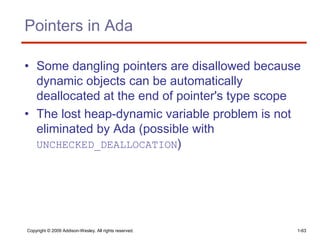

![Copyright © 2009 Addison-Wesley. All rights reserved. 1-65
Pointer Arithmetic in C and C++
float stuff[100];
float *p;
p = stuff;
*(p+5) is equivalent to stuff[5] and p[5]
*(p+i) is equivalent to stuff[i] and p[i]](https://image.slidesharecdn.com/6datatypes-170401095536/85/6-data-types-65-320.jpg)






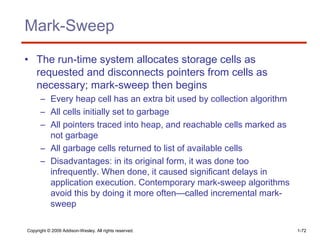



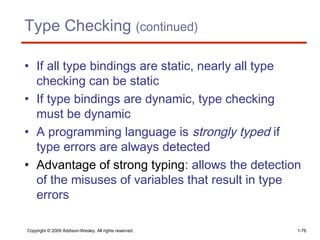




![Type Equivalence (continued)
• Consider the problem of two structured types:
– Are two record types equivalent if they are
structurally the same but use different field names?
– Are two array types equivalent if they are the same
except that the subscripts are different?
(e.g. [1..10] and [0..9])
– Are two enumeration types equivalent if their
components are spelled differently?
– With structural type equivalence, you cannot
differentiate between types of the same structure
(e.g. different units of speed, both float)
Copyright © 2009 Addison-Wesley. All rights reserved. 1-81](https://image.slidesharecdn.com/6datatypes-170401095536/85/6-data-types-81-320.jpg)


